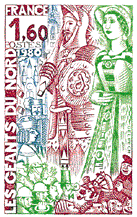|
The giants, that are typical of the folklore of the north of France, represent either of the historical heroes, or of the local trades, or of the characters who say the liveliness of the words. Introduced into mythology beside the Gods like characters closer to human, we can find them in the processions at the Average Age. They appear today only in the laic processions. |
|
 |
In Nord-Pas-de-Calais, it is no festival without giants; there are around 300. Their development was supported by the emulation between the cities as of XVIth century. Thus the first appear in 1530 in Douai (Gayant, represented here with the letter D on its shield), then 1556 in Maubeuge, 1559 in Cambrai, 1565 in Lille. The giants are born, grow, marry, have children, die, reappear. Gayant married in 1531 Marie Cageron (presents here at its sides). They have 3 children: Jacquot, Filion and Binbin say Tiot (i.e. small). In Boulogne-sur-Mer, there is Batisse and Isabelle; in Cassel, Reuze: Reuze Dad and Reuze Mama which had 4 children: Tietje, Mietje, Boutje and Maisje. |
Large processions join together sometimes more than 200 giants come from all the area, but also of Belgium or the Netherlands. Thus in Lille in 1999 for the 2000 years of the city of which the giants Lydéric and Phinaert belong, they fought in duel into 640, it was the occasion to see the giant of Berlincourt which is a dragon. The giants are carried, or pushed when they are on casters. The largest giant of Europe made 14m50 top, weighs nearly a ton and mobilizes 20 carriers which take turns by teams. To attend other events. |
|